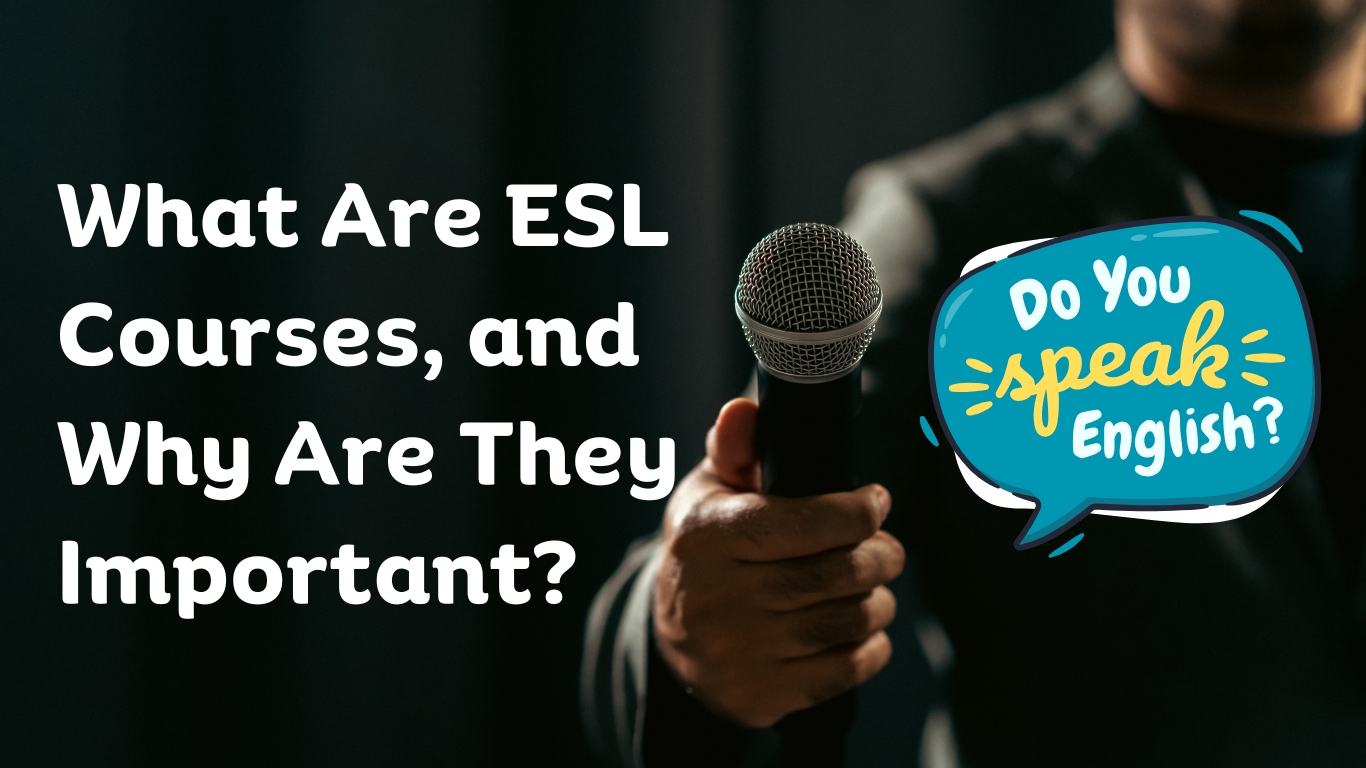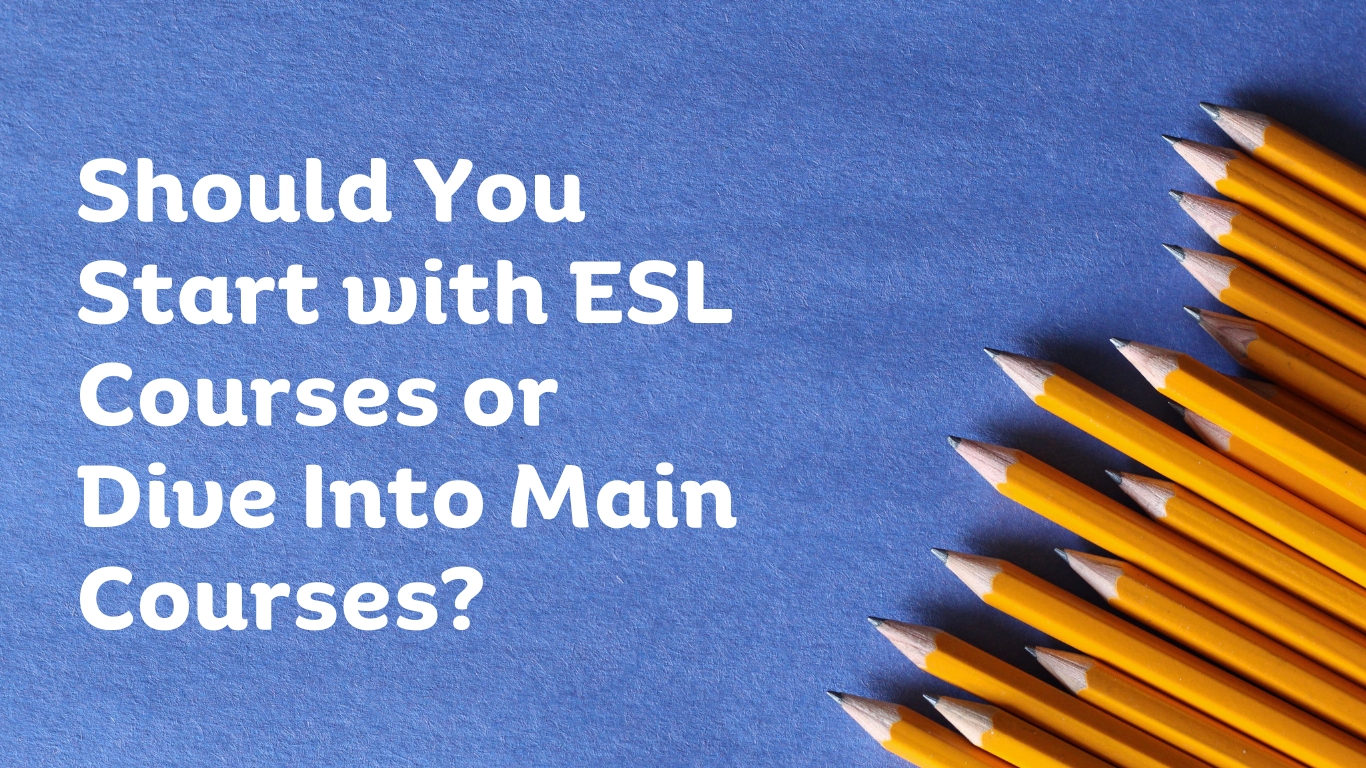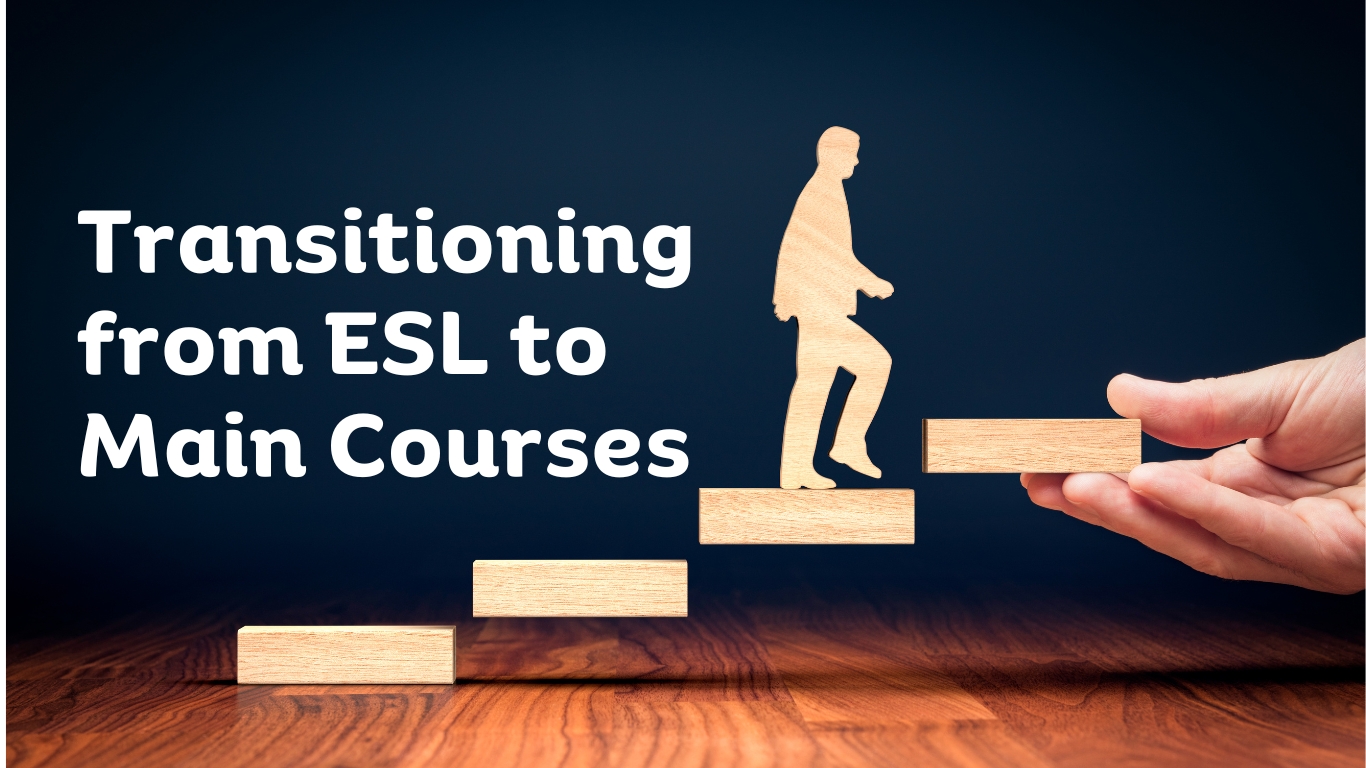Introductions
For international students, studying in the U.S. is not just about earning a degree; it's about adapting to a completely new academic and cultural environment. One of the biggest hurdles you’ll face when arriving in the U.S. is language—specifically, mastering English to the level required for academic success. Even if you're already proficient in English, transitioning into an English-speaking academic world, where you’ll be expected to understand complex lectures, write detailed research papers, and engage in discussions, can still feel challenging.
That’s where ESL (English as a Second Language) courses come into play. They serve as a vital bridge between your current language skills and the demands of U.S. higher education. For many students, taking ESL courses before diving into their main academic courses is the best way to set themselves up for success. But at some point, the question arises: how do you transition from ESL courses to main academic courses?
This journey—moving from language support to subject-specific courses—is one that many international students face, and navigating it successfully is crucial. But how do you make the right decision? Should you start with ESL courses to strengthen your English skills or jump straight into main courses related to your field of study? The answer depends on several factors, including your current English proficiency, your academic goals, and your confidence level in handling a full academic workload in English.
In this article, we’ll help you answer these questions and guide you through the decision-making process. Whether you’re considering taking ESL courses, jumping into main academic subjects, or doing both simultaneously, we’ll break down the key differences, benefits, challenges, and strategies to ensure you're making the best choice for your academic journey in the U.S.
After all, understanding when to focus on English and when to tackle your main subjects is an essential step toward making the most of your time as an international student and achieving your academic goals. So, let’s dive into the details and explore how you can set yourself up for success by understanding the role of ESL courses in your academic path and the factors that influence your decision-making process.

Let’s face it, learning English is tough, especially when it comes to academic English. Even if you’re pretty good at speaking English in everyday conversations, there’s a big gap between casual chats and understanding university lectures or writing a 10-page research paper. That’s where ESL (English as a Second Language) courses come in!
ESL courses are like your bridge to academic success in the U.S. They focus on the essential language skills you’ll need to thrive in a U.S. classroom.
Here’s what ESL courses cover:
Listening: Ever sat in a lecture and had no idea what the professor was saying? ESL courses help you understand different accents, academic terminology, and lecture speed. They’ll teach you how to catch those tricky words and phrases that go by in a blur.
Speaking: You need more than just the basics to survive discussions and presentations. ESL programs teach you how to speak confidently and clearly in both academic settings (like group discussions or presentations) and casual conversations.
Reading: U.S. textbooks can be dense. ESL courses help you read and understand everything from research papers to textbooks full of big words and complex theories.
Writing: From essays to research papers, you’ll need solid writing skills to communicate your ideas. ESL courses teach you how to organize your thoughts and write in an academic style—no more worrying about run-on sentences or grammar mistakes!
Why Should You Take ESL Courses?
Here’s a big question:
Can you imagine sitting in a lecture where you don’t understand half of what’s being said?
It’s not pretty, right?
This is exactly why ESL courses are so important. Even if you’re comfortable with everyday English, academic English is different. ESL courses provide the training you need to avoid that “I’m-lost-and-don’t-understand-anything” feeling.
Pro Tip: ESL isn’t just for beginners. Even if you’re good at English, these courses help you sharpen your skills and build confidence. After all, who doesn’t want to impress their professors with flawless academic English?

What Are Main Courses?
Main courses are the real deal—the courses that make up your degree program. These are the subject-specific courses, such as biology, business, engineering, or any field you’ve chosen to study.
Let’s break down what you’ll face in main courses:
Subject-Specific Content:
You’ll be diving deep into your chosen field. If you’re in business, expect courses on marketing, economics, and management. If you’re studying computer science, get ready for programming, data structures, and algorithms.
Rigorous Assessment:
Expect long research papers, group projects, and exams that require you to apply knowledge, think critically, and be creative.
Critical Thinking:
Main courses focus on analyzing, interpreting, and applying concepts to real-world situations. You’ll be challenged to think beyond the textbook.
Main courses demand strong English skills because you’ll be reading dense textbooks, writing research papers, and participating in discussions—all in English. If you’re not comfortable with academic English yet, those main courses might seem a little overwhelming.
Key Differences: ESL vs. Main Courses
It’s essential to understand how these two types of courses differ to plan your academic journey effectively.
| Aspect | ESL Courses | Main Courses |
|---|---|---|
| Objective | Develop English language skills. | Build knowledge in your academic field. |
| Content | Language-focused (e.g., grammar, speaking). | Subject-focused (e.g., engineering, arts). |
| Audience | Non-native English speakers. | Students proficient in English. |
| Duration | Short-term (a few weeks to months). | Long-term (semester-based or multi-year). |
| Cost | Typically lower than main courses. | Higher tuition fees, especially for international students. |
| Outcome | Prepares you for academic success. | Contributes to your degree requirements. |

Should You Start with ESL Courses or Dive Into Main Courses?
This is the million-dollar question. The decision depends on a few factors: your English skills, confidence level, and academic goals.
Here’s what to think about:
- Can I understand lectures and readings?
If you’re still unsure about following fast-paced lectures or understanding complex texts, start with ESL courses. - Am I ready to write essays and give presentations in English?
ESL will help you improve your writing, which is key for submitting high-quality essays in main courses. - Can I participate in group discussions?
If you’re not quite there yet, ESL courses will help you practice speaking in academic settings.
Pro Tip: If you’re unsure, don’t rush into main courses. Take it step by step and make sure you’re really ready.
Benefits of Starting with ESL Courses
1. Build a Strong Base
ESL courses will prepare you for the language demands of main courses. You will learn to:
- Write clear essays.
- Understand academic texts.
- Speak in class discussions.
2. Don’t Overwhelm Yourself
Jumping into main courses without sufficient language skills can lead to stress and burnout. Start with ESL so you don’t feel lost or struggle unnecessarily.
3. Get Cultural Insights
Many ESL programs include cultural orientation, teaching you about American academic and social norms. For instance, you’ll learn:
- How to address professors.
- Group participation.
- Academic integrity and not plagiarism.
Did you know? Knowing these cultural nuances can make a big difference.

Can You Take ESL and Main Courses Simultaneously?
It’s totally possible to take both ESL and main courses at the same time, but you need to manage your time wisely. Here are a few tips:
- Start Slow: Begin with one or two main courses while focusing on ESL to keep your workload manageable.
- Use Campus Resources: Writing centers, tutors, and academic workshops can help you balance language challenges with your subject-specific learning.
- Stay Organized: Time management is key. Use planners, set reminders, and keep track of deadlines for both ESL and main courses.
Pro Tip: Don’t bite off more than you can chew. If you’re taking both, be sure you have enough time for ESL study sessions, and don’t let main courses overwhelm you.

Transitioning from ESL to Main Courses
Here’s a quick guide to make your transition from ESL courses to main courses as smooth as possible:
1. Take a Placement Test
Placement tests are frequently administered by universities to assess potential students' readiness for core courses. These tests assess:
- Listening and reading comprehension.
- Academic writing.
2. Choose Introductory Courses
To get used to school, begin with less challenging classes. Start with Intro to Business or Basic Computer Skills.
3. Be Proactive
- Ask: Ask questions in class.
- Join In: Practice speaking.
- Form Group: Study with friends.

Challenges International Students Face
Transitioning from ESL (English as a Second Language) courses to your main academic courses in the U.S. can feel like jumping into a whole new world. You've learned the ropes of English, but now you're diving into subject-specific coursework that demands a higher level of language proficiency, independent thinking, and a deeper understanding of academic culture.
Let’s break down the challenges many international students face when making this shift, and how to tackle them with a bit of strategy, patience, and humor.
1. The Language Barrier Isn’t Over Yet
You may have taken ESL courses to boost your English, but when you step into your main courses, it’s a whole new level of language use. In ESL, you're learning the basics—grammar, vocabulary, speaking. In your main courses, you’ll be expected to understand academic English—a language full of jargon, complex sentence structures, and tons of new terminology.
What’s tough? Imagine sitting in a lecture on Biology and hearing terms like “photosynthesis” and “chlorophyll.” You know what they mean in English, but now you need to understand them in an academic context. This can feel overwhelming at first.
Solution:
- Pre-read your textbooks before class. You’ll get familiar with the terms and concepts in advance.
- Use online resources like YouTube, where professors often break down complex topics into simpler language.
- Study with classmates who understand the subject well. Teaching others can help reinforce your learning, and you can learn from their explanations.
Did you know? A study from the British Council revealed that 80% of international students struggle with academic English in their first year of university. But don’t worry—you’re not alone!
2. The Shock of Independent Learning
In many countries, the educational system is more structured, with teachers providing direct guidance and lectures often focusing on rote learning. In the U.S., however, the focus shifts to independent learning, where professors expect students to research, analyze, and think critically about subjects. This shift can feel like a shock if you’re not used to this level of independence.
What’s tough? You’re expected to actively participate, think for yourself, and even challenge the material presented. This can be overwhelming if you’re still adjusting to academic norms and how discussions work.
Solution:
- Start small by engaging in discussions in smaller settings, like study groups or seminars.
- Ask questions when you're unsure. U.S. professors are often very approachable and appreciate students who are engaged.
- Practice critical thinking by questioning the material you’re learning. Try to look at things from different perspectives and consider what the implications might be in the real world.
Pro tip: Studies show that students who engage actively in class discussions have higher academic performance. So, don’t be afraid to speak up!
3. Managing Time and Deadlines
The U.S. academic system expects students to juggle multiple tasks at once. You’ll have lectures, assignments, quizzes, and group projects all happening at once. Keeping track of everything can be a challenge, especially if you’re balancing ESL and main courses.
What’s tough? You may find yourself overwhelmed by deadlines, especially when professors expect you to submit papers and reports at the same time. You also need to manage your time well between your ESL and main courses.
Solution:
- Create a schedule or use a planner to keep track of assignments and exams. This can help you avoid the stress of last-minute cramming.
- Prioritize: Start with assignments that are due first, and break them into smaller, manageable tasks.
- Ask for extensions if you feel overwhelmed. Most professors are understanding and willing to work with you if you explain your situation.
Fun Fact: According to a study by Statista, over 40% of students in the U.S. admit to feeling stressed about managing their time and balancing coursework. So, you’re definitely not alone in this!
4. Navigating U.S. Academic Culture
The academic culture in the U.S. might be different from what you’re used to. While ESL courses may focus on language skills, in your main courses, you’ll be expected to understand academic integrity (no plagiarism), the art of giving presentations, and participating in debates.
What’s tough? Things like the emphasis on group work, class participation, and presentations can be intimidating, especially if English isn’t your first language. You may not feel confident enough to speak up during discussions, or you might struggle with American students' fast-paced speaking styles.
Solution:
- Join study groups where you can practice speaking and participating in discussions. You’ll get used to the rhythm of American academic conversations.
- Take advantage of workshops offered by your school, like writing workshops or public speaking sessions.
- Stay engaged with the material—the more involved you are, the easier it will be to speak up when you need to.
Did you know? A survey by National Association of Colleges and Employers found that U.S. employers highly value skills like communication, teamwork, and problem-solving—skills you’ll develop through U.S. academic culture!
5. The Transition from Comfort Zone to Challenge Zone
If you’re coming from an ESL program, you might be used to a more controlled and supportive environment. When you enter your main courses, the level of responsibility increases dramatically. This can be exciting, but it also means you need to get comfortable with handling failure and learning from mistakes—something many international students find difficult.
What’s tough? You might face setbacks in your first few main courses. The academic load can be heavy, and not every exam or paper will be perfect. This is a part of the process!
Solution:
- Embrace mistakes as learning opportunities. Every misstep is a chance to improve.
- Seek feedback from your professors. They can offer insights on how to improve your work for the next assignment.
- Stay patient with yourself. Transitioning takes time, and it’s okay not to be perfect right away.
Quick Tip: A survey by Times Higher Education showed that 68% of international students say their biggest challenge is adjusting to new academic expectations. But with persistence, most students succeed!

Costs: ESL vs. Main Courses
- ESL Programs: The expenses for participating in ESL programs vary from $1,500 to $10,000.
- Main Courses: International students are eligible for a $20,000-$60,000 fee per year for the main courses.
Save on Costs with these:
- Online ESL Programs: These are usually cheaper.
- Look for Scholarships: Some universities offer funding for language programs.
- The cost of attending a Community College is lower for both ESL and main courses.
FAQs: Common Questions Answered
1. What distinguishes ESL from conventional classes? Why or why not?
The main courses are subject-specific, while English as a second language (ESL) is defined by proficiency.
2. Does fluency in English enhance my ability to speak English well?
There are short-term courses available to enhance English language learning.
3. Are ESL lessons compulsory for all international students?
Not always. Depending on the English proficiency standards at your university and your TOEFL/IELTS scores.
4. What is the average duration of an ESL course?
It can take anywhere from a few weeks to two years, depending on your level of expertise and program complexity.
